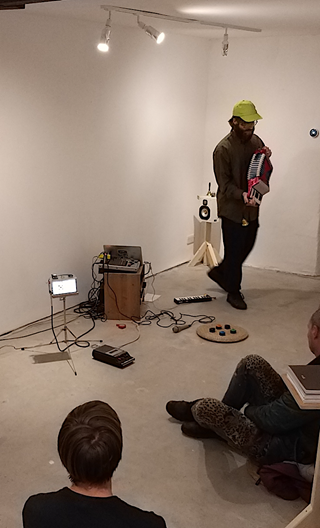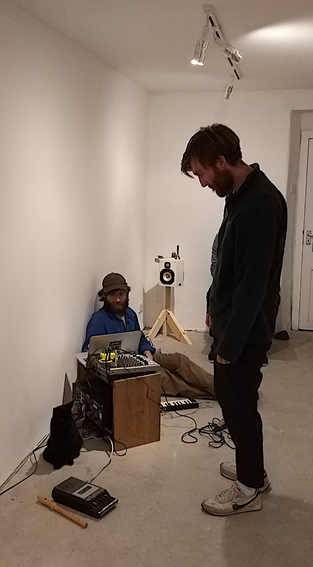|
'Changeover' at
Hweg with Ben Victor Waggett
Martin Holman
 Ben
Victor Waggett’s project at Hweg in Penzance created itself during the
artist’s two-week residency at the gallery. By that I mean that while
Waggett brought to the space the technical ‘tools’ to construct a sound
piece with some visual imagery, the material that composed the piece was
gathered inside the gallery itself. Waggett arrived empty-handed with an
open mind and an open mic. What happened then was as much in the hands
of visitors as it was in those of the artist. The collaboration was
collaged into a 20-minute soundscape presented at the closing finissage. Ben
Victor Waggett’s project at Hweg in Penzance created itself during the
artist’s two-week residency at the gallery. By that I mean that while
Waggett brought to the space the technical ‘tools’ to construct a sound
piece with some visual imagery, the material that composed the piece was
gathered inside the gallery itself. Waggett arrived empty-handed with an
open mind and an open mic. What happened then was as much in the hands
of visitors as it was in those of the artist. The collaboration was
collaged into a 20-minute soundscape presented at the closing finissage.
Waggett set up his equipment at more or less ground level. The far
corner of the room harboured the artist himself during opening hours, a
two-and-a-half chord miniature fan organ, some whistles, an accordion, a
portable cassette recorder and a few tiny bells, all of which had
visible retro credentials. And that was as material as the project went;
every physical element was ancillary to the main event. The instruments
had the same collateral relationship to the eventual collage that
brushes and pigment assume to an exhibited painting.
Nonetheless, the bells and whistles, keyboards and tape machine snuck
into the overall experience. For instance, had Waggett wanted to
generate some visual impressions for his audience, one could have been
of the popular era of home recording in the 1960s. Another might arise
from the similarity his angular encampment implied with the stealthy
installation of listening devices by ghosthunters in search of evidence
for paranormal activity.
I strongly suspect, however, that diversion into that class of allusion
was accidental. Such notions anyway clashed with the technology of the
digital age manifested in the midst of the bygone apparatus by the
artist’s sleek, silver lidded laptop, a microphone and speakers, plus a
small-scale mixing desk emitting coils of black cable tidied into
colour-coded tags. None of those details appeared to be included as
aesthetic choices. Instead, practicality prevailed: the computer was
loaded with video and sound recording software for editing. And overhead
a palm-sized video camera attached to a ceiling beam caught the entire
scene in its sights.
This gathering of instrumentation and paraphernalia is aimed at
immateriality. As an artist, Waggett demonstrates a supreme sensitivity
to his surroundings. He has described aspects of his wide-ranging
practice as a kind of exercise in field recording, translating and
transcribing ‘psycho-geographic walks, location- specific associations,
confabulations, found artefacts and field recordings into
semi-fictitious landscapes’. Transcription can take a variety of forms;
for instance, he describes using drawing as primary research
methodology. Graphite powder, putty, eraser and emulsion on canvas might
constitute a drawing, but so might drawing a line on a wall with chalk
while walking, filming the walk and recording the ambient commotion.
Chalk, pencil and microphones become substitutes for human senses, for
the susceptibility of the individual to a place and for how that place
is experienced.
It strikes me that Waggett’s work is absorbed in observation and
recording – both carried out somewhat askance. At Hweg visitors
involuntarily activated the environment with their presence. Their
voices in dialogue with Waggett and others, and their footfall
continually remodelled the atmosphere. Their contributions were not
given passively; the purpose of the project was known to them. By
participating in the opportunities offered them to utilise the objects
set out about them, the reality of that space was embellished by their
consenting agency. The equipment assumed the role of the acritical
witness, the seeing eye and listening ear that remembered. The
soundscape emerged from how the interior was used by the people who
briefly occupied it in the transient fashion of everyday life.
Waggett, who is now based in Penzance and previously worked and studied
in London, has form in this regard. Last year, under the moniker of
Burhlap, he assembled an aural impression of a damp and draughty cabin
on the Hayle Towans overlooking St Ives Bay. Such diversions suggest a
rural, sound equivalent of poet Charles Baudelaire’s nineteenth-century
flâneur, the casual wanderer, observer and reporter listening to the
kaleidoscopic manifestations of the life (in Baudelaire’s case) of a
modern city. In the first half of the last century philosopher Walter
Benjamin transformed him into an observer of the damaging effects of
modernity and capitalism. However, Waggett, similarly drawn to the
l’éternel du transitoire, adopts a less commentative position, alert
instead to the communal value of the same pursuit, an intuitive
comprehension of a place .
 ‘A
science of relations and ambiences’ is how psychogeography is often
defined. ‘Psychogeography is the fact that you have an opinion about a
space the moment you step into it,’ wrote Wilfried Hou Je Bek. ‘This has
as much to do with the space as with our hardwired instincts to
determine if it is safe.’ Waggett is a psychogeographer by inclination,
a traveller whose map of a place is drawn differently to the
cartographer’s because roving instinct is more important than fixed
positions. Psychogeography grows from observing emotions and behaviours,
and the art gallery is a prime location for its study. As a shared
collective setting, it is a covered micro-plaza where consciousness and
the unconscious, past and present, new and old, question and discovery
intermingle, where those properties and more are forever animated,
re-animated, re-collected and recollected. ‘A
science of relations and ambiences’ is how psychogeography is often
defined. ‘Psychogeography is the fact that you have an opinion about a
space the moment you step into it,’ wrote Wilfried Hou Je Bek. ‘This has
as much to do with the space as with our hardwired instincts to
determine if it is safe.’ Waggett is a psychogeographer by inclination,
a traveller whose map of a place is drawn differently to the
cartographer’s because roving instinct is more important than fixed
positions. Psychogeography grows from observing emotions and behaviours,
and the art gallery is a prime location for its study. As a shared
collective setting, it is a covered micro-plaza where consciousness and
the unconscious, past and present, new and old, question and discovery
intermingle, where those properties and more are forever animated,
re-animated, re-collected and recollected.
On Friday, 3 February, Waggett performed the soundscape edited from
hours of recordings. In the same way that his contributors among the
Penzance public had helped build it, his presentation was not passive
but responsive. Eschewing the obvious role of artist-creator, he built
upon the edit he had made by assuming the role of one more participant
in the project. As the music of the past two weeks played and interwove
itself around layers of casual talk in the gallery, the passing street
noise and occasional calls from Koyangi, the resident house cat, Waggett
improvised his response in live performance, using the same objects that
visitors had handled during their visits. The outcome was strangely
mesmeric. Often atonal and, above all, exploratory and revelatory. The
performance might not have captured the music of the spheres, but
Waggett had distilled the sound of existence, confirming that there is
no such place as nowhere, that everywhere is sonic and audible.
Hweg is outstanding for the clarity of its shows, where work is
installed in an uncluttered space that is nonetheless warm and invested
with character, all qualities in rare supply in too many commercial and
public venues in Cornwall. The gallery is establishing itself as
location for explorative contemporary art practices. Its independence is
its strength and that arises from the open-mindedness and energy of its
owner, Joe Lyward. He accepts the risks as well as the opportunities,
and to him should go both the thanks of visitors and the credit of the
region’s community of artists inspired to work in interesting ways. That
approach does not limit Lyward’s ambitions because they are centred on
the artist and not the sometimes apparently laboured task of being a
gallery. He provides space for exchanges to happen in an atmosphere that
is cooperative and welcoming. The outcome is seldom less than creative
and memorable: people take away with them after-images that can
themselves lead to the new.
'Changeover' was one example. Alongside Waggett’s project, the room
hosted a stack of books contributed by curator Julia Gros. The book,
titled ‘Rather Fly than Walk’, documents in diary form two French
photographers’ (Alex Peneau and Romain Moinier) immersion in Californian
skateboarding culture. Behind the books hung a repeated, representative
photograph from the photo-project that Gros had facilitated. Two pieces
of borrowed red furniture, generous in their proportions and inviting
repose, completed the installation that dovetailed into Waggett’s part
of the residency fortnight, ensuring that something new was going to
arise. Decamped in opposite corners, the two corresponded across the
space of the gallery, two entities in the same community.
Changeover: Julia Gros and Ben Victor Waggett took
place at Hweg, 34 Causewayhead, Penzance, between 21 January and 3
February 2023. https://www.victorwaggett.co.uk
Martin Holman is a writer based in Penzance. He is a regular contributor
to Art Monthly and the Burlington Magazine.
|